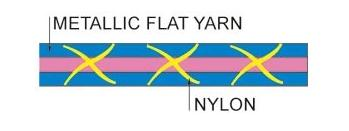The May 2024 issue of IEEE Spectrum is here!
Electroluminescent threads could be used for fashion and medical monitors Silver Sequins

A new electroluminescent thread can be embroidered directly into garments and bags and survive multiple wash cycles.
Gone are the days of humdrum fibers that do nothing beyond holding together the clothes we wear and bags we carry. In a paper published on 3 January in Science Advances, researchers from Purdue University, in Indiana, have created a new prototype of electroluminescent thread that can glow blue, green, and yellow while maintaining its shape, even under the rigors of machine embroidery.
Chi Hwan Lee is an associate professor of biomedical and mechanical engineering at Purdue and the senior author on the new paper. He says that electroluminescent thread offers an opportunity to incorporate smart features and detectors into clothing and wearables that traditional fibers or even LEDs alone can’t accomplish.
“This research aims to solve the challenge of integrating light-emitting elements into textiles in a way that preserves the inherent qualities of the fabric, such as flexibility and washability,” Lee says. “This approach not only enhances the aesthetic possibilities of light-emitting textiles but also extends their practical applications, such as in emergency signaling.”
Previous attempts to include light sources on garments have either compromised the integrity of the fabric—for example, reducing its flexibility or washability—or required extreme temperature or vacuum conditions to be successful. In the case of this new prototype, the thread can be sewn using a standard embroidery machine and was tested to survive at least 50 washing cycles.
Part of what made the electroluminescent thread possible, Lee says, was designing threads that could hold up to the stresses of embroidery. “Their compatibility with standard embroidery machines necessitates high tensile strength and a suitable elongation at the breakpoint, ensuring they can be seamlessly incorporated into fabrics without compromising their integrity,” Lee says.
The threads themselves were made with a durable nylon fiber core doped with copper or manganese for color and coated with a flexible layer of silver nanowires for conductivity. They were also coated in an additional protective layer—the researchers used Gorilla Glue—to prevent water damage.
“Durability is not just a matter of maintaining the aesthetic or functional aspects of the textiles; it’s essential for ensuring that these innovative fabrics can be integrated into everyday consumer products, ranging from fashion to emergency signaling wear, without necessitating frequent replacements or special care,” Lee says. “This resilience thus significantly broadens the scope of their use, making them more sustainable and user-friendly.”
The glowing threads can be incorporated into shirts and rugs and fashioned into interesting shapes, like a butterfly.Seungse Cho/Purdue University
In the lab, Lee and colleagues tested these threads by sewing them into several fabrics, including towels, rugs, and T-shirts. The team was able to embroider simple patterns, like a grid, as well as more complex shapes such as a butterfly, a star, and the letter P. Through wear and wash tests, the team found that the Gorilla Glue fabric sealant was an essential part of the design. With the sealant, the threads survived for more than 3 months and 50 wash cycles. Without it, the threads broke down in a month and a half as a result of oxidation, or fell apart after just a single wash cycle.
In addition to fabric tests, the team also incorporated the thread into a collision sensor designed to light up and indicate the severity and direction of a collision when attached to a football helmet.
The researchers incorporated their thread to the back of a football helmet (below the label) so that it could light up if a player took a hit to the neck.Seungse Cho/Purdue University
To mimic the kind of collisions a player might experience on the field, the team exposed the helmet to collisions with a 13.5-kilogram (30-pound) dumbbell from varied impact angles. In these tests, the impact sensor successfully lit up in the direction of the collisions, which Lee and colleagues write could be a helpful indicator for sports physicians to better assess players for concussion or other cranial damage after sustaining a blow on the field.
Beyond concussion management, Lee says that the opportunity for incorporating these threads into daily life is vast, including designing light-changing home decor and clothing, as well as providing high-visibility clothing or emergency alerts and visibility for night workers or commuters.
“Additionally, in health care, they can be integrated into wearable technology, potentially serving as visual indicators for health monitoring,” Lee says. “These applications not only showcase the threads’ versatility but also highlight their potential in transforming everyday items into interactive, functional, and fashionable pieces, aligning with the growing trend towards smart, personalized products.”
To bring these ideas to reality, one aspect the team will have to work on is shrinking the threads’ power supply, which is currently a clunky power bank. This could be potentially achieved through energy-harvesting techniques, Lee says.
Sarah Wells is a science and technology journalist interested in how innovation and research intersect with our daily lives. She has written for a number of national publications, including Popular Mechanics, Popular Science, and Motherboard.
Continued: Electroluminesce threads are good for advertising clothes, Banners, Posters,national & organizational Flags also Road & Railway track side barriers to prevent accidents during night time. Fashion designers for garment and footwear is also
Create conducive appeal for Electroluminesce clothes. For military and Civil use it would
give added advantage for night vision. It would reduce costs of Electricity consumption for night time visuality and display of Electroluminesce objects. It should be skin friendly and free from electrostatic charges.

Embroidery Thread Besides flexibility & washing of Electroluminesce wearable fabric it sh